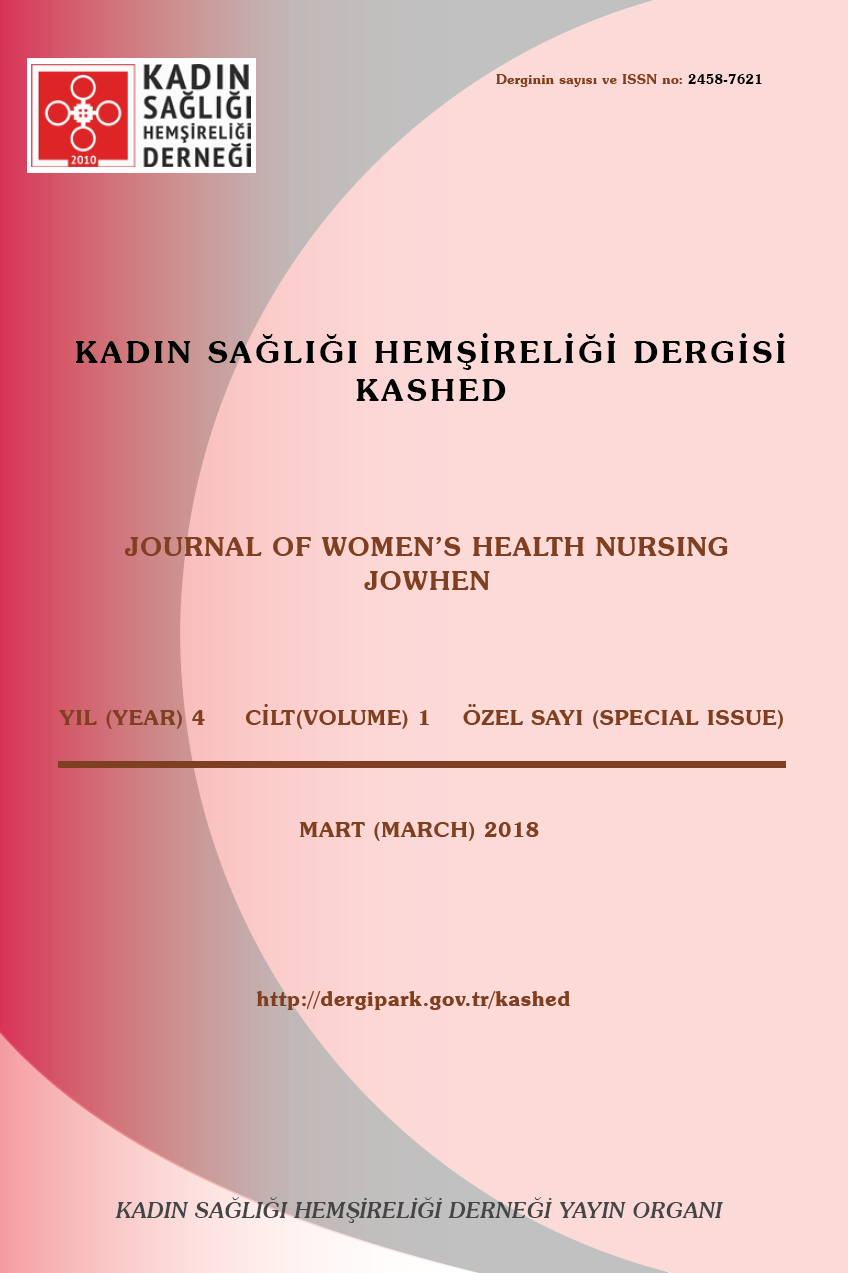Gebelik ve Tiroid Hastalıkları
Tiroid hastalıkları doğurganlık çağındaki kadınlarda erkeklere oranlara daha fazla görülmektedir. Bu hastalıkların erken tanılanması ve tedavi edilmesi hem fetal sağlık hem de anne sağlığı için oldukça önemlidir. Plasenta yolu ile fetüse hormon geçişi, idrarla iyot kaybı, gebelikte tiroid hormon sentezinin artması gebe kadınların günlük iyot gereksinimini artırır. Gebe, eğer gebelik esnasında tedavi edilmez ya da tedaviye geç kalınırsa, düşük hormon seviyesi fetüste geri dönüşü olmayan santral sinir sistemi defektlerine neden olmaktadır. Hipertiroidzm ise, eğer tedavi edilmezse, gebelik boyunca ablasyo plasenta, preeklampsi, abortus ya da prematüre doğum gibi komplikasyonlara neden olur. Bu nedenle tiroid hastalıkları gebelik öncesi erken tanılanmalı ve tedavisi başlanmalıdır.Tanılama ve tedavi aşamasında hemşireye büyük sorumluluklar düşmektedir. Hemşire, hastalığın belirti ve bulgularını erken tanılamak, gebelik öncesi, gebelik sırasında ve doğum sonuna yönelik bakım için, başta eğitici ve danışmanlık rolü olmak üzere bütün rol ve işlevlerini ön plana çıkarmalıdır.
Anahtar Kelimeler:
Tiroid hastalıkları, gebelik, fetal tiroid
Pregnancy And Thyroid Diseases
Thyroid Diseases are higher rate in women than men throuout fertility ages. Early diagnose and treatment of the diseaseare so important because of good health for pregnant women and embryo/fetüs. Due to passing hormone with placenta, losing iodine with urine, thyroid hormone synthesis in pregnancy and daily iodine requirement of pregnant also increase. Unless pregnant women cure or treatment is early, low hormone level can causes defects of central nervous system which are non-recyclable in emryo/fetüs. Unless hyperthyroidism cure, it can causes complications which are ablatio placenta, preeclampsia, abortion or premature. In this way, thyroid diseases must early diagnosed and strart early treatment.
Keywords:
Thyroid diseases, pregnancy, fetal thyroid,
___
- Allan WC, Haddow JE, Palomaki GE, Williams JR, Mitchell ML, Hermos RJ, Faix JD, Klein RZ. (2000). Maternal thyroid deficiency and pregnancy complications: implications for population screening. J Med Screen;7(3):127-30.
- American College of Obstetrics and Gynecology. (2002). ACOG practice bulletin. Thyroid disease in pregnancy. Number 37, August 2002. American College of Obstetrics and Gynecology.Int J Gynaecol Obstet;79(2):171-80.
- Andersen S, Bruun NH, Pedersen KM, Laurberg P. (2003). Biologic variation is important for interpretation of thyroid function tests. Thyroid;13(11):1069-78.
- Bostancı MS, Taşkesen F. (2011). Gebelikte tiroid fonksiyon bozuklukları ve sonuçlarının değerlendirilmesi. Klinik ve Deneysel Araştırmalar Dergisi; 2 (2): 196-201.
- Brent GA. (1999). Maternal hypothyroidism: Recognition and management. Thyroid; 9(7):661-5.
- Casey BM, Dashe JS, Wells CE, McIntire DD, Byrd W, Leveno KJ, Cunningham FG. (2005). Subclinical hypothyroidism and pregnancy outcomes. Obstet Gynecol; 105:239-45.
- Casey BM. (2006). Subclinical hypothyoridism and pregnancy. Obstet Gynecol Surv; 61(6):415-20. Çakır N. (2004). Gebelik ve tiroid hastalıkları. Türkiye Klinikleri J Endocrin;2(1):65-72.
- Fort P, Lifshitz F, Pugliese M, Klein I. (1988). Neonatal thyroid disease: Differential expression in three successive offspring. J Clin Endocrinol Metab; 66: 645-647.
- Gary F, Norman F. (2001). Medical and surgical complicationsin pregnancy. In: Cunningham FG (ed). Williams Obstetrics (21st ed). New York: Mc Graw Hill Co:1340-1348.
- Girling JC. (2003). Thyroid disorders in pregnancy. Curr Obstet Gynaecol;13 (1):45-51.
- Glinoer D. (2004). The regulation of thyroid function during normal pregnancy: Importance of the iodine nutrition status. Best Pract Res ClinEndocrinol Metab;18:133-52.
- Hatipoğlu N, Büyükkayhan D, Kurtoğlu S. (2008). Yenidoğan dönemi tiroid hastalıkları. Türkiye Klinikleri J Pediatr Sci;4(2):32-52.
- Korkmaz A, Canpolat FE, Yurdakök M, Yiğit Ş, Tekinalp G. (2005). Hashimoto hastalığı olan annelerin bebeklerinin incelenmesi: çalışma. Çocuk Sağlığı ve Hastalıkları Dergisi; 48: 20-24.
- Larsen PR, Davies TF. (2002). Hypothyroidism and thyroiditis. In: Larsen PR, Kronenberg HM, Melmed S, Polonsky KS (eds). Williams Textbook of Endocrinology (10th ed). Philadelphia: WB Saunders: 432-449.
- LeBeau SO, Mandel SJ. (2006). Thyroid disorders during pregnancy. Endocrinol Metab Clin North Am; 35:117-36.
- Mestman JH. (2004). Hyperthyroidism in pregnancy. Best Pract Res Clin Endocrinol Metb; 18(2):267- 88.
- Nader S. (2004). Thyroid disease and other endocrine diseasenin pregnancy. Obstet Gynecol Clin North Am;31(2):257-85.
- Neale D, Burrow G. (2004). Thyroid disease in pregnancy. Obstet Gynecol Clin North Am; 31(4):893-905
- Negro R, Formoso G, Mangieri T. (2006). Levothyroxine treatment in euthyroid pregnant women with autoimmune thyroid disease: effects on obstetrical complications.J Clin Endocrinol Metab;91:2587- 91.
- Ogilvy-Stuart AL. (2002). Neonatal thyroid disorders. Arch Dis Child Fetal Neonatal Ed; 87: F165- F171.
- Pop VJ, Brouwers EP, Vader HL, Vulsma T, van Baar AL, de Vijlder JJ. (2003). Maternal hypothyroxinaemia during early pregnancy and subsequent child development: a 3-year follow-up study. Clin Endocrinol (Oxf);59(3):282-8.
- Radetti G, Persani L, Moroder W, Cortelazzi D, Gentili L, Beck-Peccoz P. (1999). Transplacental passage of anti- thyroid auto-antibodies in a pregnant woman with autoimmune thyroid disease. Prenat Diagn; 19: 468-471.
- Radetti G, Zavallone A, Gentili L, Beck-Peccoz P, Bona G. (2002). Fetal and neonatal thyroid disorders. Minerva Pediatr; 54: 383-400.
- Tazegül A, Şimşek B. (2010). Gebelikte Tiroid Hastalıkları. Selçuk Tıp Dergisi; 26(2):63-67.
- Tiroid Hastalıkları, Tanı, Tedavi ve İzlem Kılavuzu. (2012). Türkiye Endokrinoloji ve Metabolizma Derneği. ISBN NO: 978-605-4011-15-5. Aysun Yayıncılık. Ankara.
- ISSN: 2458-7621
- Başlangıç: 2014
- Yayıncı: Kadın Sağlığı Hemşireleri Derneği
Sayıdaki Diğer Makaleler
POSTPARTUM DÖNEMDE CİNSELLİK VE DANIŞMANLIK
YAYGIN KULLANILMAYAN AİLE PLANLAMASI YÖNTEMLERİNE İLİŞKİN KADINLARIN BİLGİ VE GÖRÜŞLERİ
Hilmiye AKSU, Nevin AKDOLUN BALKAYA, Sevgi ÖZSOY, Gözde DEMİRSOY
EMZİRME TUTUMUNU DEĞERLENDİRME ÖLÇEĞİ
Gebelik ve Tiroid Hastalıkları
TOPLUMSAL CİNSİYET EŞİTSİZLİĞİ VE ŞİDDET
